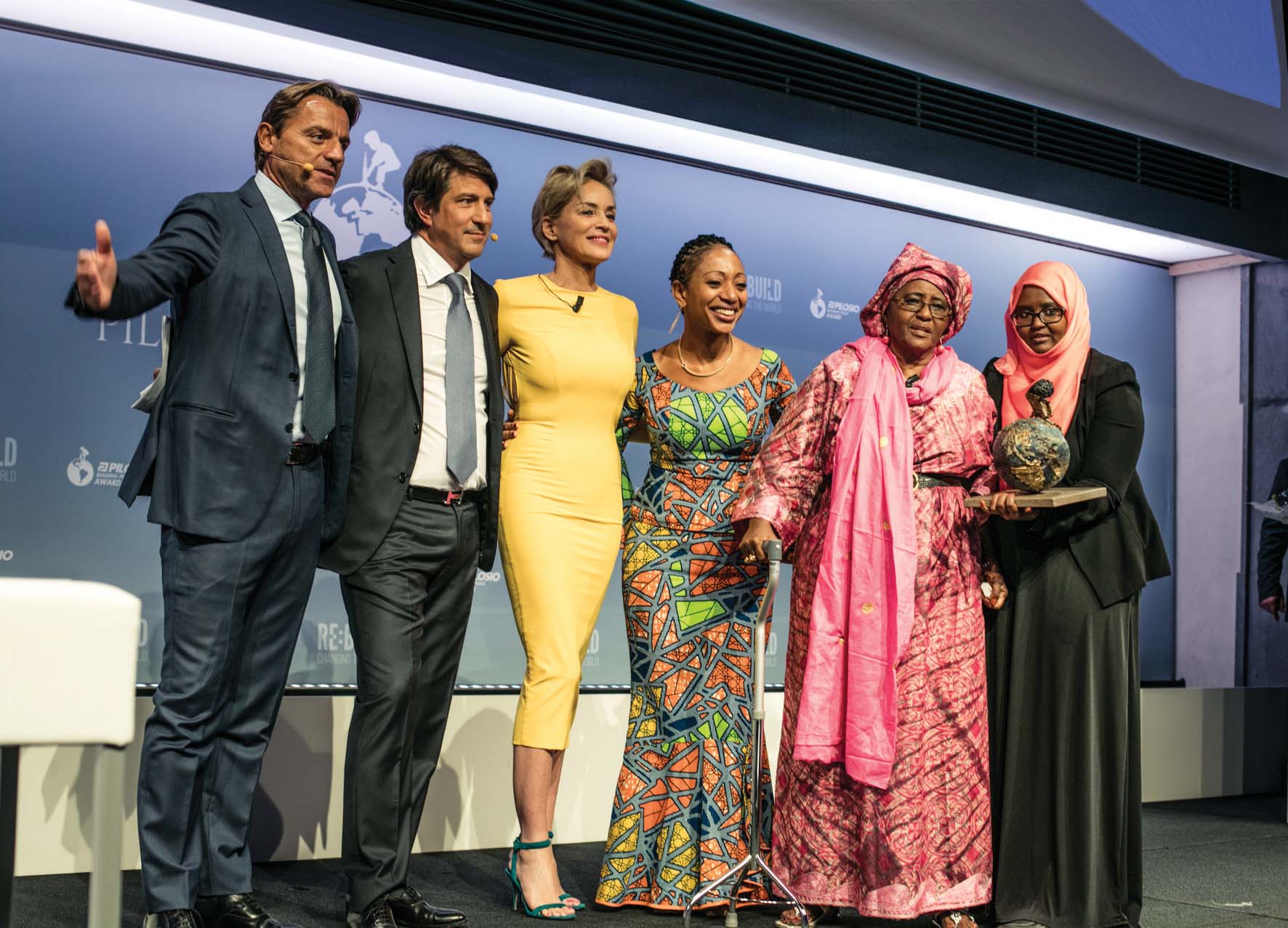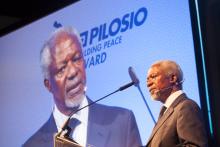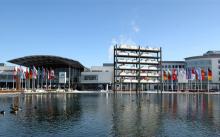Actress Sharon Stone challenged guests at the fifth annual awards in Milan to “build me a school”; they accepted. World Highways was there. What does it take to galvanise people into action to help people in need, especially refugees during a time of conflict – as in Syria now? For some it has been the recent media stories – and distressing images – of the child Aylan Kurdi, a three-year old Syrian refugee whose lifeless body lay face down on a beach in Turkey.

Pilosio is highlighting aid work and the importance of corporate responsibility with its awards
Actress Sharon Stone challenged guests at the fifth annual awards in Milan to “build me a school”; they accepted. World Highways was there
What does it take to galvanise people into action to help people in need, especially refugees during a time of conflict – as in Syria now?
For some it has been the recent media stories – and distressing images – of the child Aylan Kurdi, a three-year old Syrian refugee whose lifeless body lay face down on a beach in Turkey.
For others, it is listening to someone who cares passionately about helping others and who reaches out to simply ask, “Is anyone out there going to build me a schoo1?”
That question was enough for almost a dozen people, many of them representing large international contractors, to step forward and pledge to build a school. The person asking the question was American actress Sharon Stone, at this year’s7163 Pilosio Building Peace Award, in Milan, Italy (see box). Stone, who was guest of honour, is no stranger to aid work and was honoured by the Human Rights Campaign (HRC) in 2002 for her contribution to the fight against AIDS. In 2013 she was honoured at the Nobel Peace Prize summit in Poland for her continuing work with HIV/Aids organisations.
In truth, Stone’s reaching out to the 400 or so guests at Pilosio’s evening cocktail event was as much a challenge as an invitation. If you want a picture taken with me, she said, then build me a school.
And they came forward to stand by her on the stage. Among the donor companies were four construction firms from Canada but with Italian connections – Giusti Group from Calgary, Garcea S&J in Winnipeg, New Way Forming in Vancouver and an anonymous contractor from the province of Ontario. From Europe, international infrastructure group1303 Besix was represented, as well as Shree Property Holdings, based in South Africa, and Dream Capital, a real estate fund management firm in Australia.
The construction sector is very powerful and has a responsibility to contribute towards peace, Pilosio’s chief executive Dario Roustayan told3260 World Highways, ahead of the awards event. Importantly, the sector is also the _ rst to bene_ t from peace because it follows that infrastructure will be improved.
Roustayan is passionate about children and ensuring that those in refugee camps globally are not, as he said "a lost generation” because of a lack of schooling. There is no shortage of teachers in the Syrian camps, just a shortage of suitable school buildings, which is where he saw Pilosio is contributing towards peace. “We have to do everything possible to help bring about peace,” he said. “That is why Pilosio is now working with the Hope Village project in Somalia."
The Hope Village work is based on an innovative and proven use of Pilosio’s formwork, such as seen on road bridge construction sites. It has been used to build schools in Syrian refugee camps in Jordan. Aluminium tubing has been used to construct the frame for a small, single-storey 16m x 16m building. Metal screen sheeting covers the frame whose cavity is filled with local material such as stone and sand to form the walls.
The beauty of the building is that is not expensive and is based around the use of abundant local material. Apart from some Pilosio overseers, the work is done by local people – an important point. The hardest and most dedicated workers will always be the ones who will bene_ t most from the project. In this respect, Pilosio and the local workers are building much more than a physical structure: they are rebuilding a society – so the project’s name is Re:Build. Therein lies the power of the construction sector to change the future, said Roustayan.
The first school was built in partnership with US-based aid agency Relief International, at the Za'atari Refugee Camp, about 10km from the Jordanian city of Mafraq and only 16km from the southern Syrian border. The camp opened in July 2012 and by this summer was home to about 85,000 refugees.
A similar school is now under construction in Queen Rania Park in Amman, Jordan and is being erected by Pilosio Building Peace workers and volunteers from the city of Amman. Project Partner for this school is the international charity Save the Children.
Pilosio’s work is an example to other construction companies. “It’s just not that normal for aid agencies to work directly with construction companies,” said Adam Koons, senior vice president of international programmes at Relief International, an aid agency based in Los Angeles, California. “This is a shame because in conflicts things such as roads get destroyed and have to be rebuilt fast.”
Rebuilding roads is often one of the first things that has to be done after providing shelter, he told World Highways. But rebuilding a road is not like erecting a shelter. Because of a road’s length, it is often more complex to execute in terms of safety and security of the workforce. This has to be guaranteed over a much greater area and has to be mobile as sections of the road are finished and workers move along.
Much road rebuilding in conflict areas takes place through large international non-government organisations that let out the contracts. It is often major international companies that win a tender and then subcontract the work down several levels to local companies. This has created some issues of quality and smooth execution of the work, he said.
One aspect of road rebuilding in conflict areas has been the impact on the local community, explained Koons, who is also a trained anthropologist. Improved roads can have a bad as well as a positive benefit for local communities, something. This is too often not fully considered before rebuilding a destroyed road or putting in a new one as part of a general infrastructure rebuilding programme. Roads may be rebuilt at a central government’s request with little thought as to how better or longer highways could change the villages and towns through which they pass. Often a new or improved road connects rural economies to the greater urban areas with their larger economies and markets where more locally grown produce can be sold.
But another question is how will this improved road change the local population’s work patterns and family patterns. Will it mean people leave the local town for the larger city with greater expectations, either rightly or wrongly, a better life? Koons said these issues have not fully been explored.
Direct contact by road contractors with the people who need it most is not that common, said Cameron Sinclair, a US-based British architect and a co-designer of Pilosio’s schools. “I’ve been in this business for 20 years and I’ve never seen a road contractor walk into a refugee camp, talk to the authorities and say, ‘I want to help’,” said Sinclair, the award recipient in 2013.
That may be because of the way that construction of roads in conflict areas are tendered, he told World Highways. For example, Development Alternatives Inc. (DAI), a private development company based in Bethesda in the US state of Maryland, will tender roads contracts that will be paid for by United States government aid money. It is a supply chain issue, and it can take a long time to get work done. That is not necessarily a criticism of DAI, but construction companies could also explore other ways to help in conflict areas, said Sinclair. It depends on the refugee camp’s situation and what is needed and when it is needed.
Many construction companies, including road contractors, will have their own systems for donating time, money and their experience to charitable projects around the world. Pilosio’s school project is a good example of effective working with a charity to ensure an immediate impact on those who need it, said Philippe Dessoy, general manager of business development of Besix and who later would pledge to build a school and stood on stage with other donors.
Besix is one of Belgium’s largest construction companies and contactor for the intricately curved 1km Sheikh Zayed Bridge in Abu Dhabi, a US$66 million contract that was finished in late 2010.
Many companies have to assess what resources they can spare for any charitable work, he told World Highways. Besix does have a programme of charitable work but for smaller companies with limited resources it can be difficult to get directly involved with projects. How many employees can you afford to send off to work on projects similar to Pilosio’s projects?
The event wrapped up and the on-stage donors went out for dinner with Sharon Stone. Planning has started for next year’s Building Peace Award. But by the time the guests assemble for the 2016 event, at least 600 children who are attending Pilosio’s two schools will have started to reconstruct their own lives.
The Fifth Pilosio Building Peace Award
Pilosio is based near the Italian city of Udine in northeast Italy – 40km from the Slovenian border. The company was set up in 1961 to manufacture scaffolds and formworks for above-ground walls, floors and ground containment systems. Since 2011, Pilosio has presented its award to a person or organisation that has contributed to the improvement of a community’s or population’s living conditions.
Sharon Stone, in her role as ambassador for the Pilosio Building Peace Award, created an atmosphere of solidarity and purpose during the cocktail dinner held at the historic Palazzo Clerici in Milan.
More than €1 million was collected for the construction of 30 schools for Syrian refugees in Jordan and for creating Hope Village in Somalia. Prominent business people as well as guests joined in supporting Pilosio’s project RE:BUILD designed by Pilosio Building Peace.
Among the donors was the Royal Family of Abu Dhabi who will donate funds for the construction of up to 20 schools; three major Italian-Canadian building constructors and Claudio Tesauro, president of Save the Children Italy, will personally contribute to the construction of one school.
Giuseppe Sala, the Italian government’s representative for Milan’s international Expo Milano 2015, announced the donation of furniture and computers for the schools.
The 'Mother Teresa of Somalia'
Recipient of this year’s Pilosio award was "Mama Hawa" – Dr Hawa Abdi Diblaawe, a Somalian physician – the country’s first gynaecologist – and human rights activist. She is estimated to have saved the lives of more than 90,000 displaced people during the years of famine and civil war in Somalia. She was also a 2012 Nobel Peace Prize nominee.
She turned her family’s 525 hectare farm near the capital Mogadishu into a medical clinic and a camp in 1983. It provides care, protection and education to thousands of women and children and has grown into the Hawa Abdi Village, an island of hope for people in need. She has faced down and challenged all who have physically threatened her as well as her family, her staff and the thousands of people at her clinic.
"Extraordinary people like Hawa Abdi are a source of great inspiration for the courage and determination they have shown in fighting for their ideals," said Dario Roustayan, chief executive of Pilosio. "As entrepreneurs we want to be, and we have to be, the engine of change. In the globalised world, without peace and security there is no opportunity for business development, which is why, for those in business, giving economically is not enough; we must look beyond that."
Past recipients of the award are: 2011 - Mario Collavino, an Italian-Canadian construction company owner whose firm helped build New York’s Freedom Tower, the replacement building for the fated Twin Towers in Manhattan;
2012 - Jointly awarded to Italian architect Mario Cucinella and Munir Manneh, the UN’s representative in the Palestinian territories, for their project a Green School for Gaza; 2013 - British architect Cameron Sinclair for his project Architecture for Humanity, a global network of architects who bring design, construction and development to the world’s most di_ cult areas;
2014 - Samia Yaba Nkrumah, daughter of the founder Ghana, for her work on the Nkwame Nkrumah Presidential Library in the capital Accra.
The Hope Village Project, Somalia
Pilosio Building Peace, the Dr Hawa Abdi Foundation and Barefoot College have united to create Hope Village, an extension of the displaced persons’ camp near Mogadishu. According to the UN high commissioner for refugees, nearly a million people remain displaced in the country.
The project will allow people there to design and construct their modular buildings based upon Pilosio’s school buildings for Syrian refugees. Pilosio’s buildings in Hope Village will be used as homes, schools, meeting centres, clinics and market areas.
What does it take to galvanise people into action to help people in need, especially refugees during a time of conflict – as in Syria now?
For some it has been the recent media stories – and distressing images – of the child Aylan Kurdi, a three-year old Syrian refugee whose lifeless body lay face down on a beach in Turkey.
For others, it is listening to someone who cares passionately about helping others and who reaches out to simply ask, “Is anyone out there going to build me a schoo1?”
That question was enough for almost a dozen people, many of them representing large international contractors, to step forward and pledge to build a school. The person asking the question was American actress Sharon Stone, at this year’s
In truth, Stone’s reaching out to the 400 or so guests at Pilosio’s evening cocktail event was as much a challenge as an invitation. If you want a picture taken with me, she said, then build me a school.
And they came forward to stand by her on the stage. Among the donor companies were four construction firms from Canada but with Italian connections – Giusti Group from Calgary, Garcea S&J in Winnipeg, New Way Forming in Vancouver and an anonymous contractor from the province of Ontario. From Europe, international infrastructure group
The construction sector is very powerful and has a responsibility to contribute towards peace, Pilosio’s chief executive Dario Roustayan told
Roustayan is passionate about children and ensuring that those in refugee camps globally are not, as he said "a lost generation” because of a lack of schooling. There is no shortage of teachers in the Syrian camps, just a shortage of suitable school buildings, which is where he saw Pilosio is contributing towards peace. “We have to do everything possible to help bring about peace,” he said. “That is why Pilosio is now working with the Hope Village project in Somalia."
The Hope Village work is based on an innovative and proven use of Pilosio’s formwork, such as seen on road bridge construction sites. It has been used to build schools in Syrian refugee camps in Jordan. Aluminium tubing has been used to construct the frame for a small, single-storey 16m x 16m building. Metal screen sheeting covers the frame whose cavity is filled with local material such as stone and sand to form the walls.
The beauty of the building is that is not expensive and is based around the use of abundant local material. Apart from some Pilosio overseers, the work is done by local people – an important point. The hardest and most dedicated workers will always be the ones who will bene_ t most from the project. In this respect, Pilosio and the local workers are building much more than a physical structure: they are rebuilding a society – so the project’s name is Re:Build. Therein lies the power of the construction sector to change the future, said Roustayan.
The first school was built in partnership with US-based aid agency Relief International, at the Za'atari Refugee Camp, about 10km from the Jordanian city of Mafraq and only 16km from the southern Syrian border. The camp opened in July 2012 and by this summer was home to about 85,000 refugees.
A similar school is now under construction in Queen Rania Park in Amman, Jordan and is being erected by Pilosio Building Peace workers and volunteers from the city of Amman. Project Partner for this school is the international charity Save the Children.
Pilosio’s work is an example to other construction companies. “It’s just not that normal for aid agencies to work directly with construction companies,” said Adam Koons, senior vice president of international programmes at Relief International, an aid agency based in Los Angeles, California. “This is a shame because in conflicts things such as roads get destroyed and have to be rebuilt fast.”
Rebuilding roads is often one of the first things that has to be done after providing shelter, he told World Highways. But rebuilding a road is not like erecting a shelter. Because of a road’s length, it is often more complex to execute in terms of safety and security of the workforce. This has to be guaranteed over a much greater area and has to be mobile as sections of the road are finished and workers move along.
Much road rebuilding in conflict areas takes place through large international non-government organisations that let out the contracts. It is often major international companies that win a tender and then subcontract the work down several levels to local companies. This has created some issues of quality and smooth execution of the work, he said.
One aspect of road rebuilding in conflict areas has been the impact on the local community, explained Koons, who is also a trained anthropologist. Improved roads can have a bad as well as a positive benefit for local communities, something. This is too often not fully considered before rebuilding a destroyed road or putting in a new one as part of a general infrastructure rebuilding programme. Roads may be rebuilt at a central government’s request with little thought as to how better or longer highways could change the villages and towns through which they pass. Often a new or improved road connects rural economies to the greater urban areas with their larger economies and markets where more locally grown produce can be sold.
But another question is how will this improved road change the local population’s work patterns and family patterns. Will it mean people leave the local town for the larger city with greater expectations, either rightly or wrongly, a better life? Koons said these issues have not fully been explored.
Direct contact by road contractors with the people who need it most is not that common, said Cameron Sinclair, a US-based British architect and a co-designer of Pilosio’s schools. “I’ve been in this business for 20 years and I’ve never seen a road contractor walk into a refugee camp, talk to the authorities and say, ‘I want to help’,” said Sinclair, the award recipient in 2013.
That may be because of the way that construction of roads in conflict areas are tendered, he told World Highways. For example, Development Alternatives Inc. (DAI), a private development company based in Bethesda in the US state of Maryland, will tender roads contracts that will be paid for by United States government aid money. It is a supply chain issue, and it can take a long time to get work done. That is not necessarily a criticism of DAI, but construction companies could also explore other ways to help in conflict areas, said Sinclair. It depends on the refugee camp’s situation and what is needed and when it is needed.
Many construction companies, including road contractors, will have their own systems for donating time, money and their experience to charitable projects around the world. Pilosio’s school project is a good example of effective working with a charity to ensure an immediate impact on those who need it, said Philippe Dessoy, general manager of business development of Besix and who later would pledge to build a school and stood on stage with other donors.
Besix is one of Belgium’s largest construction companies and contactor for the intricately curved 1km Sheikh Zayed Bridge in Abu Dhabi, a US$66 million contract that was finished in late 2010.
Many companies have to assess what resources they can spare for any charitable work, he told World Highways. Besix does have a programme of charitable work but for smaller companies with limited resources it can be difficult to get directly involved with projects. How many employees can you afford to send off to work on projects similar to Pilosio’s projects?
The event wrapped up and the on-stage donors went out for dinner with Sharon Stone. Planning has started for next year’s Building Peace Award. But by the time the guests assemble for the 2016 event, at least 600 children who are attending Pilosio’s two schools will have started to reconstruct their own lives.
The Fifth Pilosio Building Peace Award
Pilosio is based near the Italian city of Udine in northeast Italy – 40km from the Slovenian border. The company was set up in 1961 to manufacture scaffolds and formworks for above-ground walls, floors and ground containment systems. Since 2011, Pilosio has presented its award to a person or organisation that has contributed to the improvement of a community’s or population’s living conditions.
Sharon Stone, in her role as ambassador for the Pilosio Building Peace Award, created an atmosphere of solidarity and purpose during the cocktail dinner held at the historic Palazzo Clerici in Milan.
More than €1 million was collected for the construction of 30 schools for Syrian refugees in Jordan and for creating Hope Village in Somalia. Prominent business people as well as guests joined in supporting Pilosio’s project RE:BUILD designed by Pilosio Building Peace.
Among the donors was the Royal Family of Abu Dhabi who will donate funds for the construction of up to 20 schools; three major Italian-Canadian building constructors and Claudio Tesauro, president of Save the Children Italy, will personally contribute to the construction of one school.
Giuseppe Sala, the Italian government’s representative for Milan’s international Expo Milano 2015, announced the donation of furniture and computers for the schools.
The 'Mother Teresa of Somalia'
Recipient of this year’s Pilosio award was "Mama Hawa" – Dr Hawa Abdi Diblaawe, a Somalian physician – the country’s first gynaecologist – and human rights activist. She is estimated to have saved the lives of more than 90,000 displaced people during the years of famine and civil war in Somalia. She was also a 2012 Nobel Peace Prize nominee.
She turned her family’s 525 hectare farm near the capital Mogadishu into a medical clinic and a camp in 1983. It provides care, protection and education to thousands of women and children and has grown into the Hawa Abdi Village, an island of hope for people in need. She has faced down and challenged all who have physically threatened her as well as her family, her staff and the thousands of people at her clinic.
"Extraordinary people like Hawa Abdi are a source of great inspiration for the courage and determination they have shown in fighting for their ideals," said Dario Roustayan, chief executive of Pilosio. "As entrepreneurs we want to be, and we have to be, the engine of change. In the globalised world, without peace and security there is no opportunity for business development, which is why, for those in business, giving economically is not enough; we must look beyond that."
Past recipients of the award are: 2011 - Mario Collavino, an Italian-Canadian construction company owner whose firm helped build New York’s Freedom Tower, the replacement building for the fated Twin Towers in Manhattan;
2012 - Jointly awarded to Italian architect Mario Cucinella and Munir Manneh, the UN’s representative in the Palestinian territories, for their project a Green School for Gaza; 2013 - British architect Cameron Sinclair for his project Architecture for Humanity, a global network of architects who bring design, construction and development to the world’s most di_ cult areas;
2014 - Samia Yaba Nkrumah, daughter of the founder Ghana, for her work on the Nkwame Nkrumah Presidential Library in the capital Accra.
The Hope Village Project, Somalia
Pilosio Building Peace, the Dr Hawa Abdi Foundation and Barefoot College have united to create Hope Village, an extension of the displaced persons’ camp near Mogadishu. According to the UN high commissioner for refugees, nearly a million people remain displaced in the country.
The project will allow people there to design and construct their modular buildings based upon Pilosio’s school buildings for Syrian refugees. Pilosio’s buildings in Hope Village will be used as homes, schools, meeting centres, clinics and market areas.








